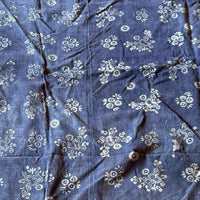

Antique Indigo Katazome Futon-ji – Wildflower, 3 Panels Wide
A softly faded antique futon-ji (布団地) featuring a delicate katazome wildflower scatter—airy, balanced, and unmistakably hand-made. Futon-ji refers to the cloth used for traditional Japanese futon covers. Before industrial looms, rural households wove cotton on narrow looms only 13.5–14" wide, then hand-seamed several panels together to create bedding textiles that were both functional and expressive.
This panel was dyed with katazome, the traditional Japanese resist-dye technique in which artisans brush rice-flour paste through hand-cut mulberry stencils before dipping the cloth repeatedly into natural indigo vats. Once the paste is rinsed away, the undyed areas reveal crisp, floating motifs. Here, the design is a field of tiny wildflower forms—likely intended for the visible top side of a futon where decoration mattered most.
The cotton has softened beautifully over time. Its even fading and lack of heavy wear indicate that it was probably part of a well-kept household trousseau or lightly used bedding stored for seasonal rotation. There are no visible repairs or structural issues, making this a strong example for reuse in garments, quilting, or display.
We estimate that this is an antique, likely early–mid 20th century (c. 1910–1940).
We estimate this date based on (1) the stencil style and density of the small-scale katazome motifs, which align closely with Taishō–early Shōwa patterns; (2) the hand-spun, hand-woven cotton typical of rural domestic production before mechanized looms became widespread in the 1940s; and (3) the absence of heavy mending, suggesting it belonged to a household that stored linens carefully rather than wearing them into later-century boro repair cycles.
Because futon-ji were utilitarian textiles that saw daily use, surviving examples in this condition almost always predate World War II.
-
Traditional katazome resist pattern in a floral scatter motif
-
Medium-weight cotton with a soft, even hand
-
Hand-sewn futon seams
-
Light fading from age; no visible mending or structural damageMade in Japan
Dimensions: 37.5" × 83.5" (95 × 212 cm)
Panels: 3 panels wide
A standard Japanese home loom produced cloth about 13.5–14" wide.
Three panels × ~13.5" each ≈ 40.5" before seam allowances → consistent with the measured width.
Made in Japan


